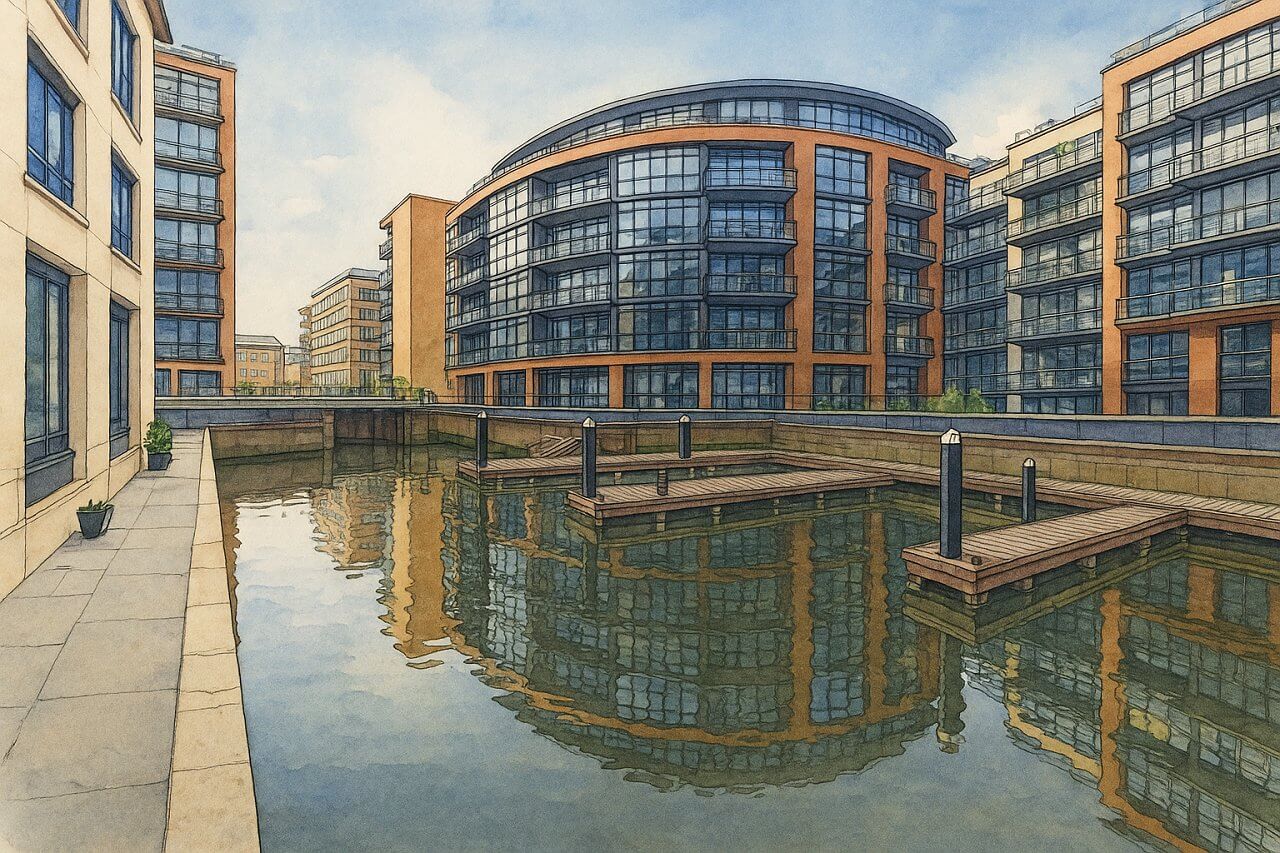
Grosvenor Canal, London
Where Is Grosvenor Canal?
Grosvenor Canal (GPS: 51.48637, -0.14918) is located in Pimlico, in the City of Westminster, southwest London. The site lies just north of the River Thames, and today forms part of the Grosvenor Waterside residential development. It's situated roughly 1.7 miles (2.7 km) southwest of Charing Cross, London’s traditional central point.
The canal is tucked between Chelsea Bridge and Battersea Bridge, with nearby landmarks including the Royal Hospital Chelsea and the Chelsea Barracks site.
What Was Here Before the Canal?
Before the construction of the canal in the 1820s, the area was predominantly marshland. The riverside land here was low-lying and undeveloped, used primarily for pasture and market gardening. It was prone to flooding and largely unsuitable for residential or commercial development.
The nearest settlement of note was the village of Chelsea to the west, and the district of Westminster to the northeast. The area remained relatively isolated until canal construction began.
The Birth of Grosvenor Canal
Constructed in the early 1820s, Grosvenor Canal was an offshoot of the River Thames, developed by the Grosvenor family estate. The canal was initially built as part of a plan to improve transport and logistics to the growing West End, particularly for bringing in coal, building materials, and refuse transport.
It extended from the River Thames at Pimlico northwards to what is now the Victoria Coach Station area. At its peak, the canal was about 1,200 metres long and was used by narrowboats and barges transporting goods into Westminster.
How the Canal Was Used
The Grosvenor Canal served both industrial and municipal purposes. It was an important artery for moving building supplies and coal into central London. Later in the 19th century, it became part of the city's refuse system, with barges transporting waste down to the Thames.
It also supported smaller wharves and depots, many of which serviced nearby power stations and industrial sites, including what would later become Victoria Station and Battersea Power Station areas.
Decline and Disuse
With the rise of railways and motorised road transport, Grosvenor Canal began to fall into disuse during the early 20th century. Its utility waned as industry moved elsewhere and freight shifted to other methods of transportation.
By the 1960s, most of the canal was no longer in active use. The northern parts were progressively filled in and redeveloped, and by the 1990s, the remaining basin near the Thames was all that survived.
Redevelopment: Grosvenor Waterside
In the early 2000s, the site was transformed into Grosvenor Waterside, a luxury residential development that preserved the last section of the historic canal basin. The redevelopment project began in 2003 and completed its main phases by 2012.
Today, the area is a mix of high-end flats, landscaped gardens, art installations, and cafes, attracting residents and visitors alike. While most of the canal no longer exists, the remaining water feature serves as a central part of the estate’s design.
Can You Visit Grosvenor Canal?
Yes, public access is available. You can stroll along the remaining canal basin at Grosvenor Waterside, which includes pedestrian paths, benches, and modern public art. Although boating is no longer a feature, the area is scenic and peaceful, with interpretive signs giving insight into its past.
How to Get There
Nearest Underground Station: The closest tube station is Sloane Square on the District and Circle lines, about a 10-minute walk away.
Bus Routes: Bus 44, 170, and 452 all stop nearby, with routes passing along Chelsea Bridge Road and Ebury Bridge Road.
Fun Fact
A small lock near the canal's mouth remains in place and is a protected structure. It's one of the last surviving canal locks in Westminster and a rare reminder of London's once-thriving canal network within the central city.
Quick Facts
- Location: Pimlico, City of Westminster, London
- Distance from Charing Cross: 1.7 miles (2.7 km)
- Constructed: 1820s
- Original Route: From River Thames to near present-day Victoria Coach Station
- Original Use: Transport of coal, materials, and refuse
- Disuse: Began in early 20th century
- Redeveloped: Early 2000s as Grosvenor Waterside
- Public Access: Yes, pedestrian paths and viewing areas
- Nearest Tube Station: Sloane Square
- Nearest Bus Routes: 44, 170, 452
- Fun Fact: Contains one of Westminster's last surviving canal locks
Grosvenor Canal is  on the Map of Pimlico, London
on the Map of Pimlico, London

Painting of Grosvenor Canal, London (View image in full size)